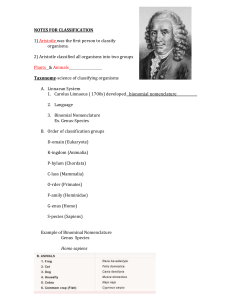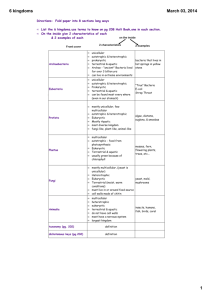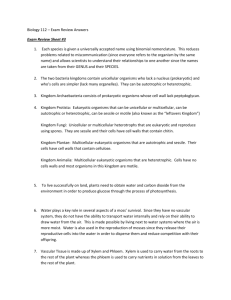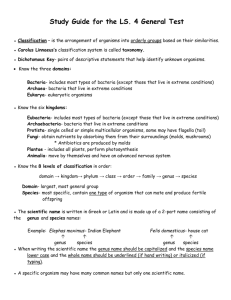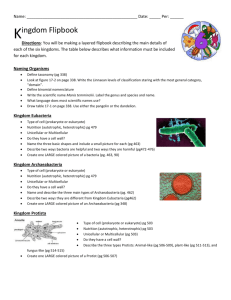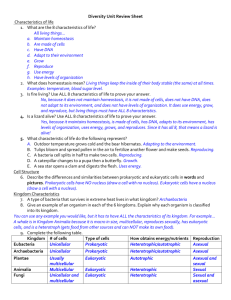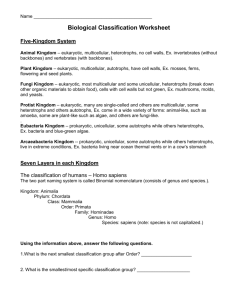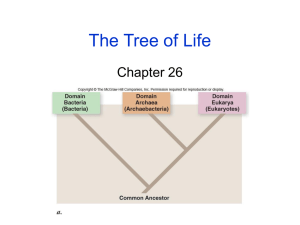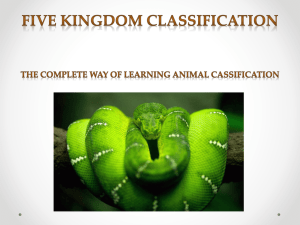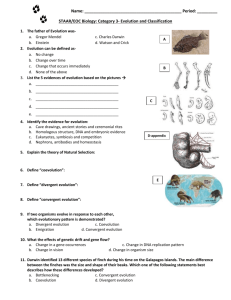Classification
advertisement
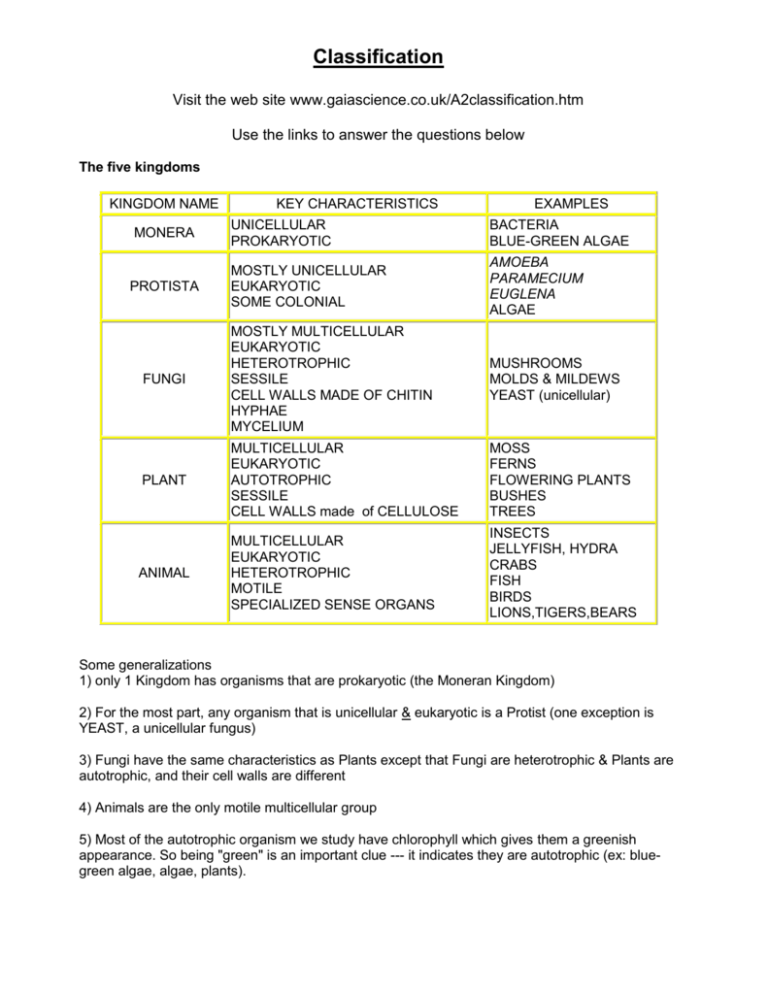
Classification Visit the web site www.gaiascience.co.uk/A2classification.htm Use the links to answer the questions below The five kingdoms KINGDOM NAME KEY CHARACTERISTICS EXAMPLES UNICELLULAR PROKARYOTIC BACTERIA BLUE-GREEN ALGAE MOSTLY UNICELLULAR EUKARYOTIC SOME COLONIAL AMOEBA PARAMECIUM EUGLENA ALGAE FUNGI MOSTLY MULTICELLULAR EUKARYOTIC HETEROTROPHIC SESSILE CELL WALLS MADE OF CHITIN HYPHAE MYCELIUM MUSHROOMS MOLDS & MILDEWS YEAST (unicellular) PLANT MULTICELLULAR EUKARYOTIC AUTOTROPHIC SESSILE CELL WALLS made of CELLULOSE MOSS FERNS FLOWERING PLANTS BUSHES TREES ANIMAL MULTICELLULAR EUKARYOTIC HETEROTROPHIC MOTILE SPECIALIZED SENSE ORGANS INSECTS JELLYFISH, HYDRA CRABS FISH BIRDS LIONS,TIGERS,BEARS MONERA PROTISTA Some generalizations 1) only 1 Kingdom has organisms that are prokaryotic (the Moneran Kingdom) 2) For the most part, any organism that is unicellular & eukaryotic is a Protist (one exception is YEAST, a unicellular fungus) 3) Fungi have the same characteristics as Plants except that Fungi are heterotrophic & Plants are autotrophic, and their cell walls are different 4) Animals are the only motile multicellular group 5) Most of the autotrophic organism we study have chlorophyll which gives them a greenish appearance. So being "green" is an important clue --- it indicates they are autotrophic (ex: bluegreen algae, algae, plants). 1. Define the key characteristics a. UNICELLULAR b. PROKARYOTIC c. EUKARYOTIC d. MULTICELLULAR e. EUKARYOTIC f. HETEROTROPHIC g. SESSILE h. AUTOTROPHIC i. MOTILE j. SPECIALIZED SENSE ORGANS k. CELL WALLS MADE OF CHITIN l. HYPHAE m. MYCELIUM 2. For each description or example, name the kingdom it belongs A. one-celled organism, eukaryotic, has structures for moving B. green, multicellular, sessile, cellulose cell walls C. an Ameba D. multicellular, eukaryotic cells, obtains food from its environment, flies E. colony of eukaryotic cells, autotrophic F. sessile, heterotrophic, multicellular G. eukaryotic cells with cell walls composed of cellulose H. unicellular, no nucleus visible I. yeast J. bacteria Principles of taxonomy The principles and importance of taxonomy is a classification system which comprises of a hierarchy in which groups are contained within larger composite groups with no overlap. Each hierarchy (monera, protista, fungi, plat and animal) comprises of Kingdom, Phylum, Class, Order, Family, Genus, Species. (remember – King Peter Could Only Fry Green Sausages!) Phylum The phylogenetic groupings are based on patterns of evolutionary history. Throughout evolutionary history points of divergence have been identified, for example reptiles and birds separated after mammals and reptiles had become separated as classes of organisms A phylum is the first subgroup within a kingdom. Click on the first link to complete the characteristics for the phyla in the animal kingdom. The first phylum, chordate or vertebrates is done for you. The rest of the phyla are invertebrates KINGDOM MONERA PROTISTA FUNGI PHYLUM CHARACTERISTICS EXAMPLE(S) blue-green algae autotrophic blue-green algae bacteria heterotrophic Streptococcus Staphylococcus algae (plant-like) autotrophic "sea weeds" diatoms Spirogyra protozoa (animal-like) heterotrophic Amoeba Paramecium the thing to remember about this kingdom is that most are multicellular (mushrooms, molds, mildew) and a few are unicellular (yeast). don't worry about specific phyla names. :) bryophyte nonvascular plants (small & simple) mosses liverworts tracheophyte vascular plants trees flowering plants ferns Chordate Animals with backbones Mammals, fish, reptiles, amphibians, birds PLANTS Arthropod Cnidaria Platyhelminth ANIMALS Nematode Echinoderm Annelid Mollusc Class Click on the link below to complete the table looking at how the phylum chordate is split into different classes and then find example for each by searching on Google Class Chondrichthyes Osteichthyes Amphibia Reptilia Aves Mammalia Features Example Scientific name. 1. What is meant by binomial nomenclature? 2. Why do you think organisms are given a scientific name? 3. Why are humans referred to as Homo Sapiens? Answer the questions and check your answers at the bottom of the link Species 1. Define a species 2. Why are lions and tigers said to be of different species? Using the information you have discovered answer the following questions: 1. The mammals form a class called the Mammalia within the animal kingdom. The grey wolf is a species of mammal. Figure 1 shows the groups within the Mammalia to which the wolf (labelled W) belongs. Figure 1 a) Label Figure 1 to show the names of the groups. b) The lion, Panthera leo, belongs to another group in the Carnivora, called the Felidae. Add this information to Figure 1, using the letter L to represent the lion species. c) The diagrams show two systems of classification of mammals. Figure 2 shows a simple hierarchy. Figure 3 shows a phylogenetic system. d) What is meant by a hierarchy? e) By reference to Figures 2 and 3, explain how a phylogenetic system differs from a simple hierarchy. 2. Use your knowledge of classification to arrange class, phylum, genus and family in order of decreasing number of species. largest number of species …………………. smallest number of species ……………………. ……………………. ………………… 3. The diagram shows an amoeba. This is a single-celled organism. Amoeba is classified as a protoctist. Giving a different answer in each case, explain why it is not (i) a prokaryote; (ii) a fungus.
